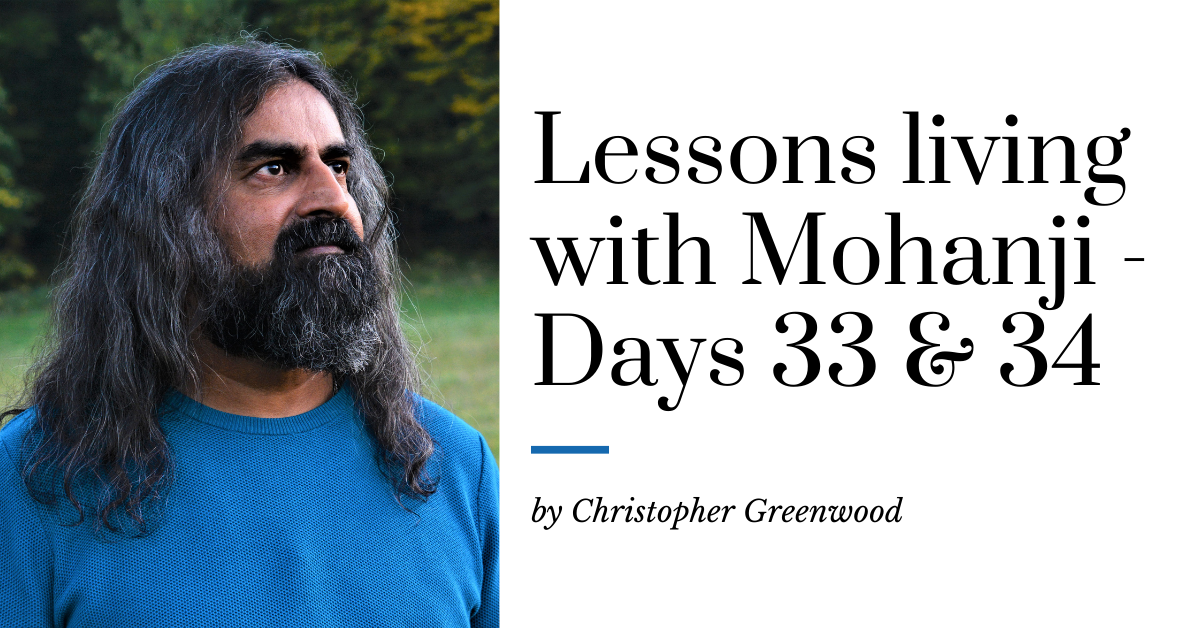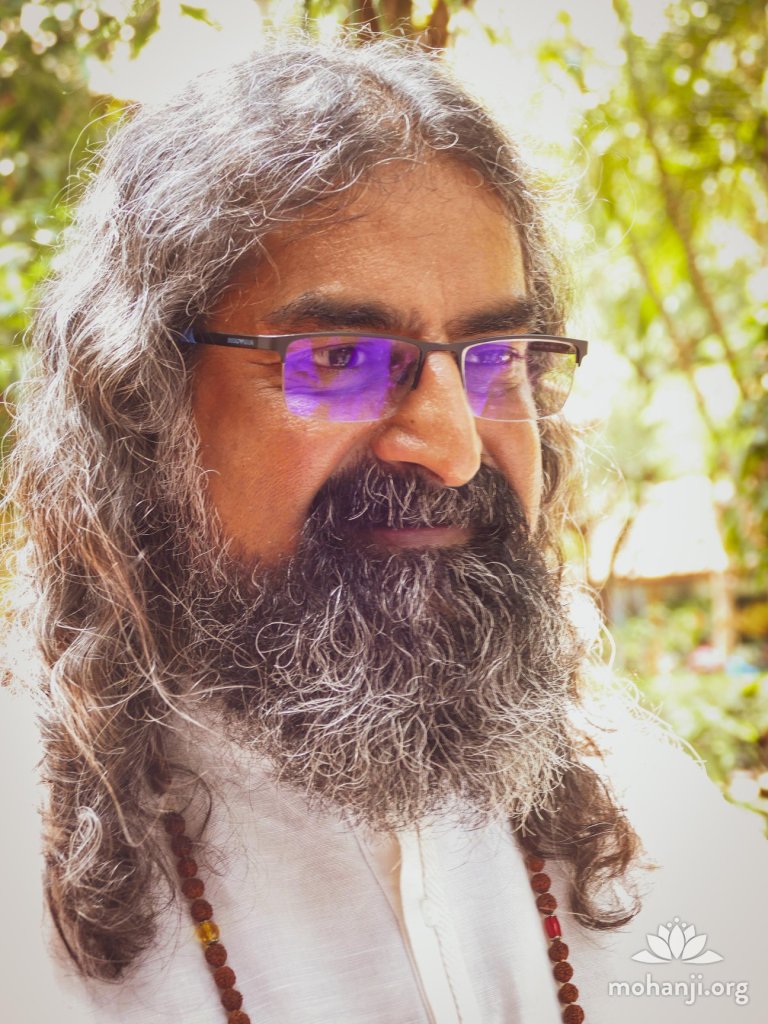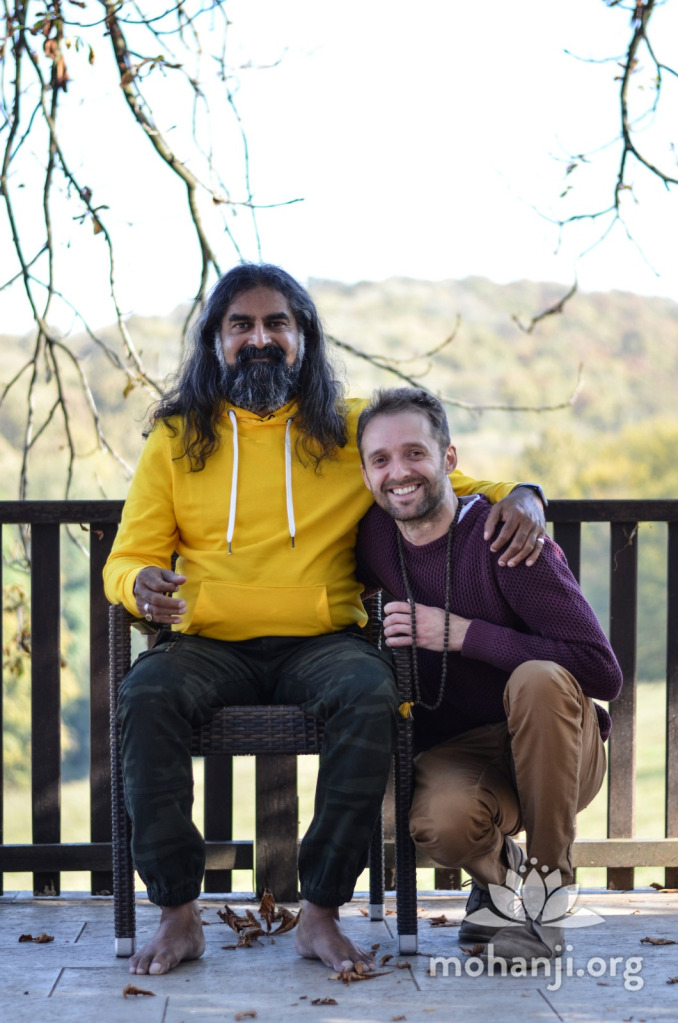Day 33 Lesson – Quick fixes or liberation?
Good morning, everybody. I hope you’re doing well today.
Spending this time with Mohanji has given me an opportunity to observe all the varieties of people, situations and events that come to him to handle. There’s a mixture of these, and he’s looking after many things a day.
A lot of them is helping resolve situations, problems and troubles for people. I’d say this is by far the largest percentage of people that are coming to Mohanji. They are looking for some kind of solution. Many come to him because they’ve reached a dead end. They want a problem to be fixed, whether it’s about work, or losing a job (either themselves or someone in the family), or there’s a health complication (with a family member or themselves), or there’s a marriage and relationship problem or, for example, someone has acquired a lot of debt, and now they want Mohanji to fix it, make it go away.
It’s various situations like this, and I’m giving examples of general categories rather than any actual specifics. But, when there’s a problem, they’d like Mohanji to help. I say this with no judgment. It’s a reality and my observation of what I can see here.
I also see that the people already have developed expectations; they have an idea of how Mohanji will help them and what he’ll do. If this isn’t possible, if it’s not as they expect, then they can be just as quick to criticise, as they were to ask for help in the first place, when they thought it was available, or that something was going to happen for them. So, it’s a real transactional connection.
Then some other people are really committed and want to cut across the cycle of birth and death. They understand that there is a path that Mohanji is showing, the path that can bring liberation from this circus of life: birth after birth, the same patterns, life after life. They stay. Some people within the family have been with Mohanji for many years, which I really admire and respect because they’ve been steady for over ten years, maybe even more.
Then, there are others who may have reached certain positions or heights. Then, for some reason, maybe their expectations exceeded that purpose; they’ve also left too.
Like this, there is a mixture of people. I feel that the main difference is in their purpose and why they’re connecting to Mohanji, whether they’re coming with expectations or coming with more awareness and acceptance of what’s being provided.
I’m saying this because we recently had a session on karma in the Bootcamp hosted by the ‘Invest in Awareness’ team. Mohanji explained really well that what we experience in this life is the result of our hard-earned karma, i.e. what we’ve learned from the past, mixed with some of our lineage or family karma. But essentially, we have a karmic roadmap. Sometimes, we lose sight of this. This means that everything we are experiencing in life is actually the result of all our activities that have happened before – all the good experiences and all the bad experiences. Whether we are aware of it or not is a different question, but we’ve earned it.
What Mohanji has provided is this platform through which we can serve and help change that. But I think people find it easier not to think of this and then blame others. Some people even blame Mohanji or other masters when actually it’s got nothing to do with them because it’s our karma or the person’s karma that’s at play.
But what I can see from Mohanji is that he always does what he can, as he openly says. I’m a witness to almost daily events of someone’s transformation or a resolution in someone’s life. But of course, he says that he has to respect karma. If people are connecting to him deeply, then he is already doing what he can. He can’t remove karma, but what he can do is reduce the intensity. As I understand that, it means that when I’m connected to him – if anything is happening in my life, both the good and the bad situations, it probably would have been much worse and serious if I wasn’t connected to him.
So that’s the observation for today. I wanted to share that – through Mohanji – there is a path to liberation, which some people have set as their purpose. Then, there’s also a mixture of people who are coming for the quick fix solutions for the problems of life.
But I know, from Mohanji’s point of view, all are accepted, all are welcome. As he says, he does his job. No one goes empty-handed.
I hope you have a great day and speak to you soon.
Day 34 Lesson – What more can I do?
Good morning, everybody.
Today, I’ll share more details about Mohanji’s style and approach to work. I think many people listening to this would have heard Mohanji say that as soon as he wakes up, he asks himself, “What else can I do for the world?” Being with him now, I can say that he’s never really satisfied with things as they are; he always wants to do more. He believes that more can be done, and he explores this constantly.
This is why the majority of our morning conversations revolve around that topic. What else can we do? What more can we do? And that’s not just me; I just happened to be there sitting in front of him – it’s the collective we. It’s the Foundation; it’s everybody involved, all the teams, all the heads of the organisations, all the various platforms, such as Ammucare, Act4Hunger, Invest in Awareness, or World Consciousness Alliance.
Since spending my time here, I’ve realised that many of the ideas and initiatives we see are all coming from Mohanji, even some of the tasks which I need to complete. He openly asked me, “Why do I have to give you all these ideas? Why aren’t you thinking?” Today, was an example of this.
Someone must have shared a video with him, a really touching and moving video about a poor homeless man. In the video, a lady gave him some money, and at that moment, she lost her wedding ring. The ring dropped into the cup that he was collecting money in. When he emptied the cup, he found it and had a flashback, he remembered her.
So, he went looking for her, to see if he could give the ring back. He passed a pawn shop. It’s one of those shops where you can exchange rings, electronics, or other expensive goods for money. So he had a dilemma. He went in, he presented the ring, and the man offered, I think, $4,000. So, the homeless man could have gotten the money, but he decided to keep looking for the lady. Eventually, he found her. Then this lady started a crowdfunding campaign out of thankfulness. The campaign raised a substantial amount of money, which she donated to him. It was much more than the ring was worth.
So this was the video. Mohanji asked, “Can we make videos like this? Can we get videos going?” Again, “Is it only me that’s thinking of these ideas?”
This was a small example of how he’s living what he says daily, and it’s an inspiration. He’s looking for what more we can do to improve, what more can we do to develop ideas. Because when we do that, when we move with what we have, enhance it, add to it, we have the potential to reach more people.
For Mohanji, this is constant; this is the way he is, which is a real inspiration. Even though he’s in his 50s, he shares the same enthusiasm as somebody in their 20s, always looking for something new. In the boot camp for the corporate program, we’ve spoken about the different types of people, categorising them into six broad categories. The first category is the type of people who have no vision, no plan, and no motivation to do much really. So they just live; they exist. Then, at the opposite end of the spectrum are people who have a plan, have a vision, have the will, have determination, and deliver it. But they don’t stop there. They’re always looking for what more they can do.
For myself, I’ve noticed that in my past, and even now sometimes, that once I’ve achieved something, I’ll have the will or the desire to achieve it, but once it’s been completed, then I’ll almost stop, I would rest. But what I’ve begun to learn, especially since being in Mohanji’s energy, is that this leads to stagnation. It can lead to lethargy and even inertia.
Now, it’s a constant process of developing that attitude towards – “What more can we do?” So I’m thinking, what more can I do with these responsibilities that I have because there are always ways to enhance and improve what I’m doing.
In my previous work as well, I’d often become dissatisfied once I’d reach a position. Then generally, my workday would be very mechanical. You know, I just do the same thing, day in, day out. So there wouldn’t be many variations for improvement, even though the work was varied.
Now, looking back, I realised that that’s when my self-esteem would start to become affected. Because there was no more progress, it was the same thing day in, day out. I didn’t really have the attitude of “What more can I do to improve.”
But observing Mohanji it’s been an inspiration because he’s showing through his life and how he works that there’s always more that we can do with what we have, no matter how small the improvement. So, if we’ve got something to do, we can keep exploring it. We can look at all the dimensions and all the possibilities so that we can create a freshness to it, a freshness to the task or responsibility, and then it keeps growing.
I think this is really important to understand and practice because it can bring new motivation to the work. This can be really important across all the platforms because if everybody had the attitude of, “What more can I do, what can I change today, what small improvements can we make”, we would move very far, we’d be reaching the lives and the hearts of many more people around the world.
To put this into practice amongst my team, we’ve implemented a small routine, which everybody will pick up every morning. Once we’ve spent time with ourselves, done our morning practice, we sit for 10 or 20 minutes, assess all the work and all the responsibilities we have that day. Then each of us will think of new ideas and new ways to improve what we’re doing. So, I’m excited to see what change comes from this. Maybe it’s something that you want to try out and give a go, too.
Thank you for listening, and I hope you have a great day ahead.
|| JAI BRAHMARISHI MOHANJI ||
Edited & Published by – Testimonials Team, 20th June 2021
Disclaimer:
The views, opinions, and positions expressed by the authors and those providing comments on these blogs are theirs alone and do not necessarily reflect the views, opinions or positions of Mohanji, Mohanji Foundation, it’s members, employees or any other individual or entity associated with Mohanji or Mohanji Foundation. We make no representations as to accuracy, completeness, timeliness, suitability or validity of any information presented by individual authors and/or commenters on our blogs and will not be liable for any errors, omissions, or delays in this information or any losses, injuries or damages arising from its display or use.
We reserve the right to delete, edit, or alter in any manner we see fit blog entries or comments that we, in our sole discretion, deem to be obscene, offensive, defamatory, threatening, in violation of trademark, copyright or other laws, of an express commercial nature, or otherwise unacceptable.
— Mohanji Testimonials Team







